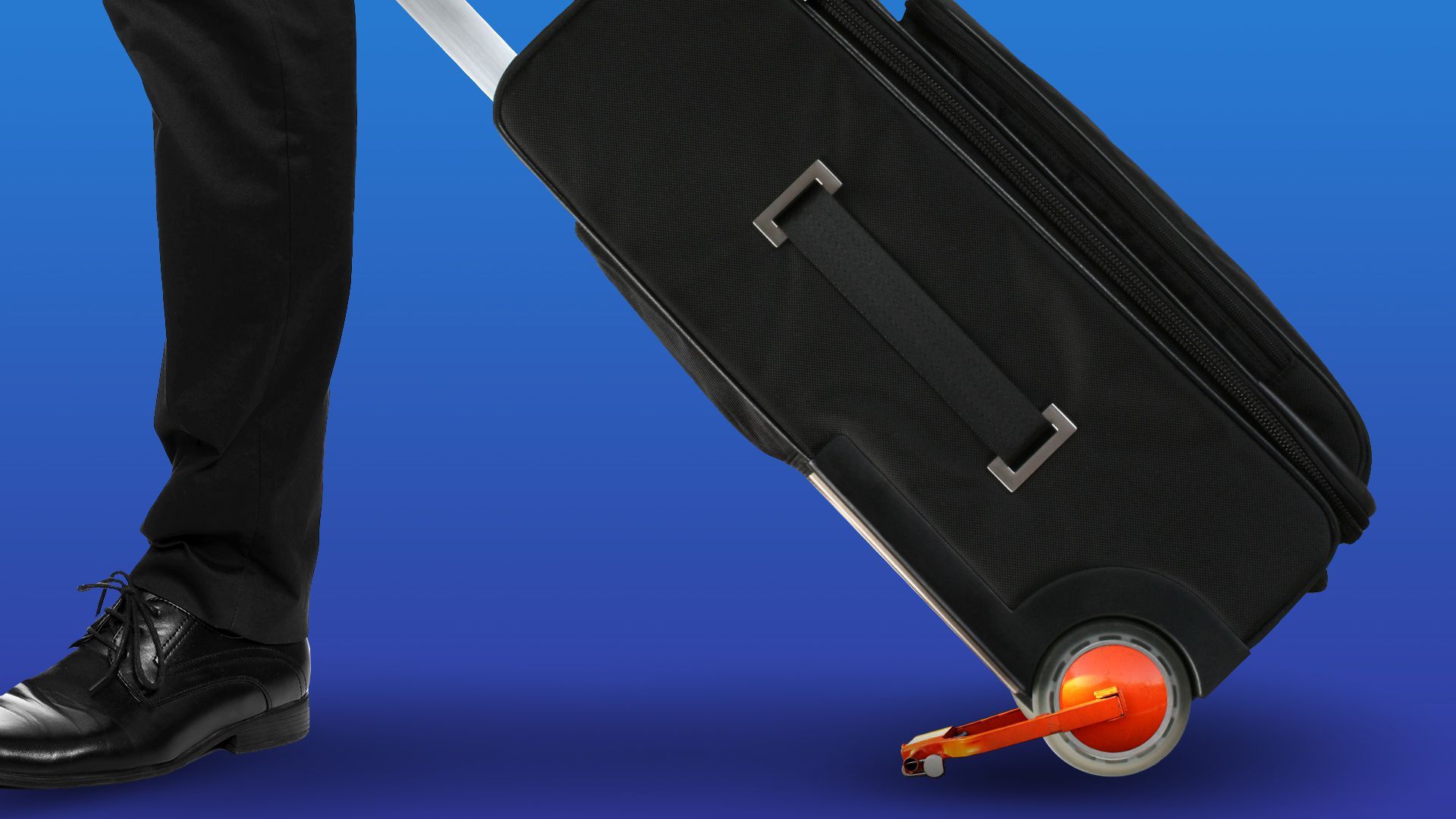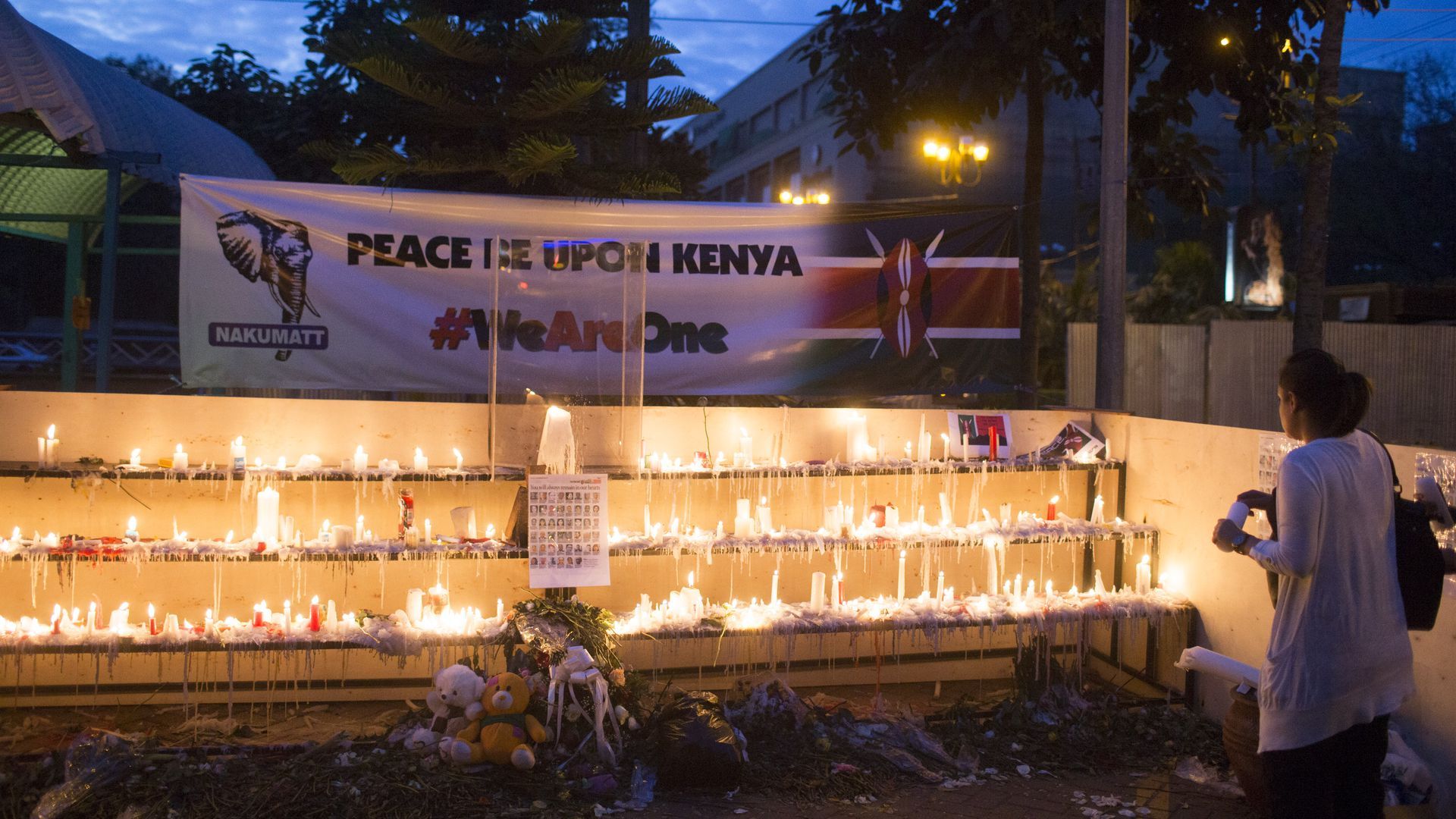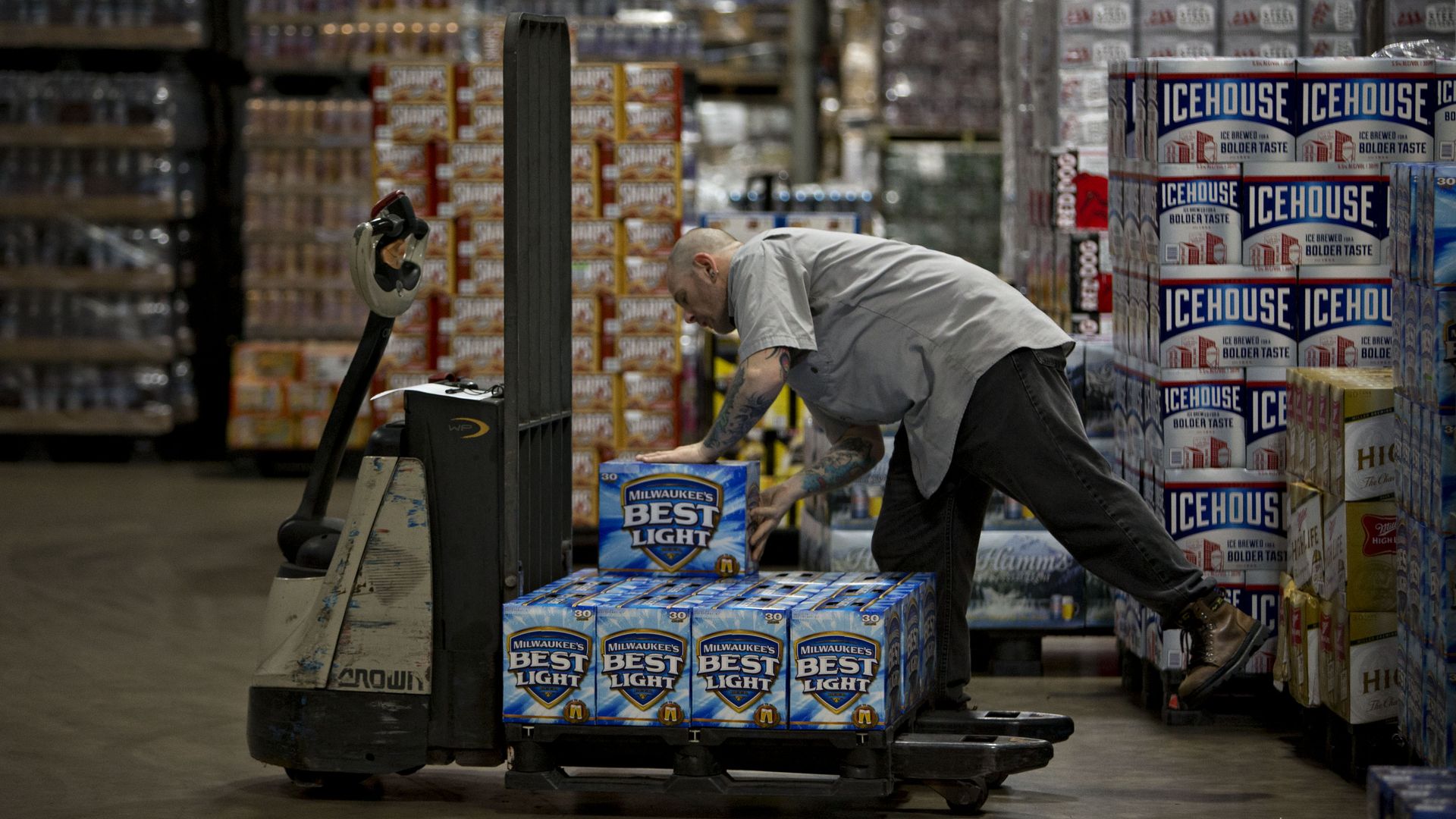| | | | | | | Presented By General Motors | | | | Axios What's Next | | By Bryan Walsh, Joann Muller, Erica Pandey and Jennifer A. Kingson ·Aug 03, 2021 | | Tuesday brings you the uncertain state of business travel, electric cargo planes and the lamented demise of cheap beer. "What was next" trivia: On this day in 1807, which former U.S. vice president went on trial for treason? Hint: Talking less and smiling more didn't work for him. - Credit to reader Paul Gressling for being the first to note that on Aug. 2, 1909, Abraham Lincoln became the first person on a U.S. coin.
- Send your answer, along with tips and feedback, to whatsnext@axios.com.
Today's Smart Brevity count: 1,356 words ... 5 minutes. | | | | | | 1 big thing: Business travel might be going out of style |  | | | Illustration: Annelise Capossela/Axios | | | | Companies have made it a year and a half mostly without traveling for work — and now more and more of them are considering dramatically reducing business travel to slash costs and cut carbon emissions, Erica Pandey writes. Why it matters: Business travel is a massive part of the global economy — with trillions of dollars and millions of jobs at airlines, hotels and travel agencies hinging on its return. By the numbers: Corporate travel is coming back but is projected to remain at just 30% of 2019 levels by the end of 2021, according to a new Deloitte survey of travel managers at firms across industries. - Half of the surveyed companies say they're adjusting their travel strategies to be more sustainable. 76% say they're turning more internal meetings that would require flying into online ones, 58% say they'll do fewer business trips overall and 55% say they'll specifically look at cutting back on international corporate travel.
- Two-thirds of respondents say they'll reduce the frequency of business trips to save money.
What they're saying: "Companies used to send maybe eight people to close a deal. Now they'll send two people, and the rest will be on Zoom," says Charlie Leocha, president of Travelers United, a passenger-advocacy organization, and one of the architects of a recent Wall Street Journal analysis that projected the pandemic would permanently reduce business travel by 20%-40%. The stakes: Business travelers only make up around 10% of airline passengers across the major global carriers, but they account for 55%–75% of revenue because they're typically the ones who spend big on last-minute tickets or book premium seats, the New York Times' Jane Levere reports. - A permanent setback in corporate travel could push airlines to bump up prices or reduce routes, Leocha says — both of which would hit leisure travelers.
But, but, but: Some parts of business travel will bounce back, experts say. - There are all sorts of business trips, from corporate retreats to sales pitches to trade shows. "And what you see is a fair amount of variation in terms of what will come back and at what pace," says Vik Krishnan, leader of McKinsey's travel practice in North America.
- Conferences and trade shows will come back because "you can't network on Zoom," says Leocha. And when it comes to pitching to clients, "there's a 'fear of missing out,'" Krishnan says. "Most companies will probably end up doing what their competitors do."
- On top of that, some of the pre-pandemic business trips that disappear will be replaced by new types of trips spurred by our new way of working. Companywide retreats are becoming more frequent and more elaborate as companies embrace remote and hybrid work, Axios' Bryan Walsh notes.
What to watch: Business travel is getting hit by international travel restrictions as well as uncertainty around the Delta variant of the coronavirus, says Krishnan. Recovery will speed up once restrictions loosen and the pandemic is more fully under control, he says. Read the rest |     | | | | | | 2. DHL to add Eviation's electric cargo planes to its fleet |  | | | DHL Express' electric cargo plane. Image: Courtesy of DHL Express | | | | Logistics provider DHL Express is adding electric cargo planes to its fleet, becoming the first customer for Eviation, a Seattle-based electric aviation company, Joann Muller writes. Why it matters: As delivery on demand explodes, shipping and logistics providers like DHL are under pressure to make every mode of their operations more sustainable — aircraft, trucks, last-mile delivery vans and even their buildings. DHL has committed to spending 7 billion euros ($8.3 billion at today's rate) by 2030 for steps to reduce its CO2 emissions, on its way to a zero emissions target by 2050. Driving the news: DHL said today it has ordered 12 fully electric Alice cargo planes from Eviation and expects to take delivery in 2024. Details: Alice, which can be configured for cargo or passengers, requires 30 minutes or less to charge per flight hour and has a maximum range of about 500 miles. - It can be flown by a single pilot and carry up to 2,600 pounds, and can operate in environments where piston and turbine planes are currently used.
- As with electric automobiles, fewer moving parts means reduced maintenance costs and increased reliability, according to Eviation.
- Its operating software constantly monitors flight performance to ensure optimal efficiency. A first flight is scheduled for later this year.
Read the rest |     | | | | | | 3. A model to predict terror attacks ahead of time |  | | | People light candles for the victims of the Westgate shopping mall attack in Sept. 2013 in Nairobi, Kenya. Photo: Uriel Sinai/Getty Images | | | | A new study details a theoretical model that can help predict where terrorism attacks will occur up to a week in advance, Bryan Walsh writes. Why it matters: Much of the power of a terror attack derives from the quality of surprise. Being able to reliably predict when and where attacks are likely to occur would potentially blunt terror as a tool and reduce the costs of security. What's happening: In a study published Friday in Science Advances, researchers outlined a framework that uses publicly available data about terror incidents around the world between 2002 and 2016 to identify which factors might reliably tip off authorities in advance of a likely attack. - The locations of previous attacks had the best predictive value — if terrorists thought a location was worth attacking once, there's a higher chance it'll be worth attacking again.
- In addition, population density, the travel time to the nearest city, road network density and economic activity (in part as quantified in night lighting that can be seen via satellite) all correspond to higher likelihood of attack.
By the numbers: In regions with a high prevalence of terrorism, the model was capable of predicting up to 51% of attacks a week in advance. The catch: For areas with a low prevalence of terrorism — like the U.S., for example — the model is much less capable of predicting attacks in advance, simply because there is so little data to draw from. Share the story |     | | | | | | A message from General Motors | | Progress moves when everybody's in | | |  | | | | General Motors is investing $35 billion globally in EVs and AVs through 2025 and offering access to nearly 60,000 places to charge across the U.S. and Canada. Why it's important: By creating a seamless charging experience, GM's investment is electrifying the future. | | | | | | 4. The double-sided risk of bad vaccine communication |  | | | Illustration: Aïda Amer/Axios | | | | The public conversation around who's at risk as the Delta variant continues to spread in the U.S. has gone off the rails, and it's very possible that it will just get worse, Caitlin Owens writes. What we're watching: Even as experts and officials try to put vaccinated Americans' risk in context, the world is still gathering data on the vaccines' effectiveness. - Reassuring the majority of vaccinated Americans they d0n't need to freak out could backfire if it causes those who are at risk to let down their guard.
Driving the news: Public health experts spent the weekend trying to reassure vaccinated Americans that they're not at a high risk of coronavirus infection, and certainly not of hospitalization or death. - But at the same time, researchers around the world are trying to determine how much the vaccines' effectiveness against severe disease wanes over time, and some countries are going ahead with booster shots for immunocompromised and elderly people.
Between the lines: Risk may look a lot different for vaccinated nursing home residents and older Americans, especially those who received their shots early on, than a vaccinated 20-something without any health conditions. - The number of nursing home cases is rising, and breakthrough cases are more problematic in nursing homes, tweeted Ashish Jha, dean of Brown's School of Public Health.
- "A breakthrough infection, which might be a nuisance for a healthy person, can be very serious for a frail person," he wrote.
Read the rest |     | | | | | | 5. 1 drinking thing: Goodbye to cheap beer brands |  | | | A beer distributor warehouse in Illinois. Photo: Daniel Acker/Bloomberg via Getty Images | | | | Beer giant Molson Coors will discontinue 11 of its economy brands, the company's CEO said last week, Bryan writes. What's happening: The brands that will be sunset include Milwaukee's Best Premium (though not its ice or light varieties), Keystone Ice and Miller High Life Light. - "The headline is simple: Premiumization is here to stay at Molson Coors," CEO Gavin Hattersley said in a call with analysts Thursday.
Thought bubble: If you're anything like me, just the names of those brands will evoke the taste of foam, the sight of red Solo cups, and the feeling that you probably should have ended last night about two hours earlier. Context: Sales of beer have been falling for years in the U.S., even as drinking overall is on the rise. The bottom line: Molson Coors will focus on premium brands, hard seltzers and even CBD drinks, because America's twentysomethings still like to get buzzed, even if it's not with cheap beer. |     | | | | | | A message from General Motors | | Progress moves when everybody's in | | |  | | | | General Motors is investing $35 billion globally in EVs and AVs through 2025 and offering access to nearly 60,000 places to charge across the U.S. and Canada. Why it's important: By creating a seamless charging experience, GM's investment is electrifying the future. | | |  | | It'll help you deliver employee communications more effectively. | | | | | | Axios thanks our partners for supporting our newsletters. If you're interested in advertising, learn more here.
Sponsorship has no influence on editorial content. Axios, 3100 Clarendon Blvd, Suite 1300, Arlington VA 22201 | | | You received this email because you signed up for newsletters from Axios.
Change your preferences or unsubscribe here. | | | Was this email forwarded to you?
Sign up now to get Axios in your inbox. | | | | Follow Axios on social media:    | | | | | |









No comments:
Post a Comment